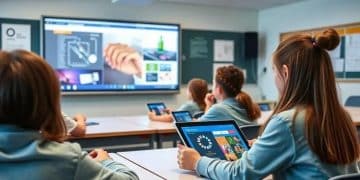Important learning disability support: essential strategies

Important learning disability support encompasses effective strategies like differentiated instruction, technology integration, and strong collaboration between parents and educators to enhance educational outcomes for students facing challenges.
When it comes to important learning disability support, many parents and educators often wonder how best to help. This guide offers insights into effective strategies that can make a real difference in educational outcomes.
Understanding learning disabilities
Understanding learning disabilities is crucial for creating inclusive educational environments. These disabilities can affect how individuals process information, making traditional teaching methods less effective. By learning about the various types of learning disabilities, teachers and parents can tailor their support to meet each child’s unique needs.
Types of Learning Disabilities
There are several common types of learning disabilities that can affect students:
- Dyslexia – challenges with reading and language processing.
- Dyscalculia – difficulties with math concepts and calculations.
- Dysgraphia – issues with writing skills, affecting spelling and handwriting.
- Auditory Processing Disorder – trouble understanding sounds, affecting language comprehension.
Each of these disabilities presents different challenges in the classroom. For instance, students with dyslexia may struggle with reading assignments, while those with dyscalculia may find math equations overwhelming. By understanding these challenges, educators can implement appropriate strategies.
Recognizing Learning Disabilities
Recognizing learning disabilities early is important for helping students succeed. Signs to watch for include:
- Struggles with basic reading and writing.
- Difficulty following instructions.
- Problems remembering and organizing information.
- Unusual levels of frustration when doing schoolwork.
For parents and teachers, being observant and acknowledging these signs can open the door to support. Early intervention can lead to better outcomes and boost a child’s self-esteem.
In addition, it’s essential to foster open communication between teachers and families. By discussing a child’s progress together, they can formulate a plan that addresses specific learning needs while encouraging a love for learning.
Key support strategies for educators
When it comes to providing learning disability support, educators play a vital role. Key support strategies can significantly enhance the educational experience for students facing challenges. By implementing effective methods, teachers can create an inclusive environment that caters to the diverse learning needs of their students.
Differentiated Instruction
Differentiated instruction is a powerful technique that involves tailoring lessons to meet individual student needs. This can include:
- Modifying assignments based on skill levels.
- Utilizing various teaching styles to engage different learners.
- Providing additional resources for struggling students.
- Encouraging group work to foster collaboration.
By embracing differentiated instruction, teachers can ensure that all students, regardless of their abilities, can participate and thrive in the classroom.
Use of Assistive Technology
Integrating assistive technology is another effective strategy to support students with learning disabilities. These tools can help bridge gaps by offering:
- Text-to-speech programs for struggling readers.
- Speech-to-text software for writing assignments.
- Interactive apps that reinforce learning concepts.
- Visual aids to enhance understanding.
When used in combination with traditional teaching methods, assistive technology can empower students to overcome barriers and succeed academically.
Moreover, it is essential for educators to maintain open communication with parents. Sharing information about students’ progress and discussing strategies that work can enhance the support students receive. Collaboration fosters a unified approach to education, ensuring that students feel supported at home and in school.
Role of parents in supporting children

Parents play a crucial role in providing learning disability support to their children. Their involvement can make a significant difference in how children cope with their challenges and thrive academically. By being proactive and engaged, parents can help build a strong foundation for their child’s success.
Understanding the Diagnosis
One of the first steps for parents is to understand their child’s specific learning disability. This knowledge allows them to:
- Advocate effectively for their child in school settings.
- Collaborate with teachers to create personalized learning plans.
- Be aware of potential emotional impacts of the disability.
By learning about the disability, parents can foster a supportive home environment that nurtures their child’s strengths.
Encouraging Communication
Open communication is essential for supporting children with learning disabilities. Parents should encourage their kids to express their feelings and challenges. By doing this, parents can:
- Provide reassurance and validate their child’s experiences.
- Help them develop problem-solving skills.
- Create a safe space for discussing school experiences.
It is important for children to know they are not alone and that their parents are there to help navigate the difficulties they face.
Additionally, parents should communicate regularly with educators. Attending school meetings and discussing their child’s progress helps create a united front. Collaboration between home and school enhances the support provided to children.
Involvement in educational activities at home can also help. Simple strategies, such as reading together, participating in homework, or using educational games, can reinforce learning and build confidence.
Technological tools for learning disabilities
Technological tools can play a significant role in providing learning disability support. These resources help students overcome challenges and enhance their learning experiences. Incorporating technology into the classroom can offer tailored solutions that meet individual needs.
Assistive Software
There are various types of assistive software designed specifically for students with learning disabilities. These tools can support different learning styles by:
- Providing text-to-speech capabilities to help with reading.
- Offering speech-to-text for writing tasks.
- Utilizing graphic organizers to assist with brainstorming ideas.
- Incorporating educational games that make learning fun.
By using assistive software, students can gain confidence and improve their academic skills.
Apps for Learning Support
In addition to software, many apps are available that cater to learning disabilities. These apps often provide interactive and engaging ways to reinforce concepts. Popular options include:
- Math apps that allow practice through games and quizzes.
- Reading apps featuring stories read aloud for better comprehension.
- Time management apps that help students keep track of their assignments.
- Note-taking apps that offer visual aids and organization features.
Technology empowers students by making information accessible and learning more enjoyable. It allows them to work at their own pace and provides instant feedback.
Furthermore, technology in the classroom should complement traditional teaching methods. Educators can combine these tools with hands-on activities, ensuring that all students benefit from a well-rounded educational experience.
Successful case studies in education
Exploring successful case studies in education can provide valuable insights into effective strategies for supporting students with learning disabilities. These examples demonstrate how specific approaches can lead to positive outcomes.
Case Study 1: Inclusive Classroom Practices
At a public elementary school in California, teachers implemented inclusive practices. They used differentiated instruction to tailor lessons for students with various abilities. This allowed each child to engage with the material at their own level. As a result, the school reported:
- A 30% increase in student participation.
- Improved reading scores among students with learning disabilities.
- Enhanced collaboration between staff and parents.
These practices fostered a supportive environment where all students thrived.
Case Study 2: Technology Integration
A high school in Texas introduced technology tools specifically designed for students with learning disabilities. They provided access to apps and software for reading and writing assistance. The implementation led to:
- A 40% rise in writing proficiency scores.
- Increased student engagement through interactive learning.
- Positive feedback from parents on their children’s progress.
This case highlights the transformative impact of technology when used properly in educational settings.
Furthermore, both cases show the importance of continuous training for educators. Professional development ensures that teachers are equipped with the latest strategies to support diverse learners effectively. Collaboration with specialists also enhances the overall educational experience.
FAQ – Frequently Asked Questions about Learning Disability Support
What are learning disabilities?
Learning disabilities are neurological disorders that affect a person’s ability to read, write, speak, or solve math problems, impacting their overall learning process.
How can technology help students with learning disabilities?
Technology provides tools such as assistive software and apps that support reading, writing, and organization, making learning more accessible and engaging.
What role do parents play in supporting children with learning disabilities?
Parents help by understanding their child’s needs, communicating with teachers, and creating a supportive home environment for learning.
Why is collaboration between educators and parents important?
Collaboration ensures that both home and school environments work together to support the child’s learning, maximizing their potential for success.






